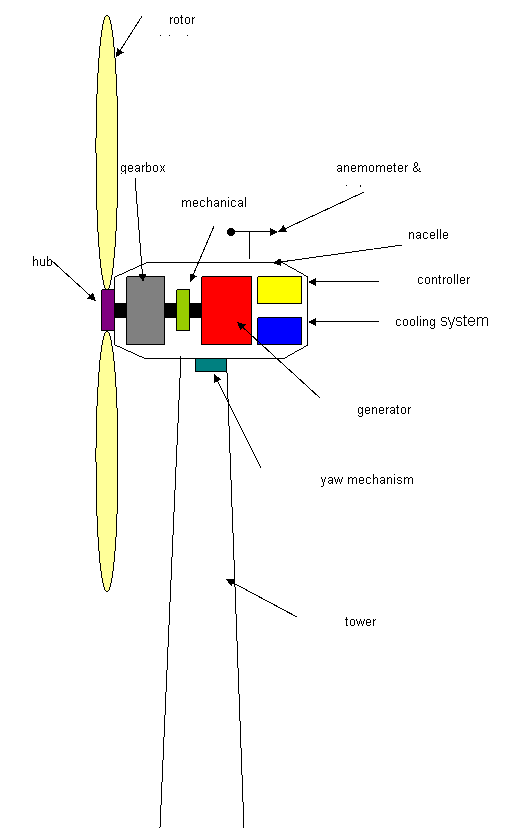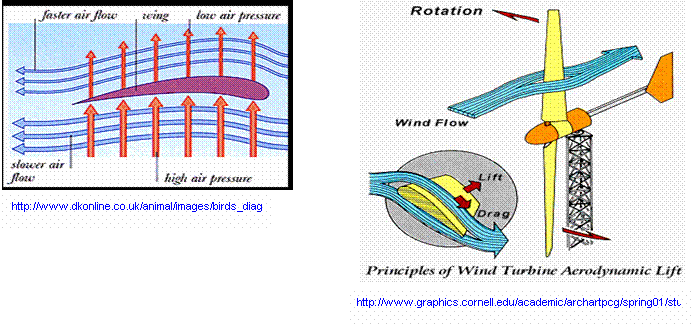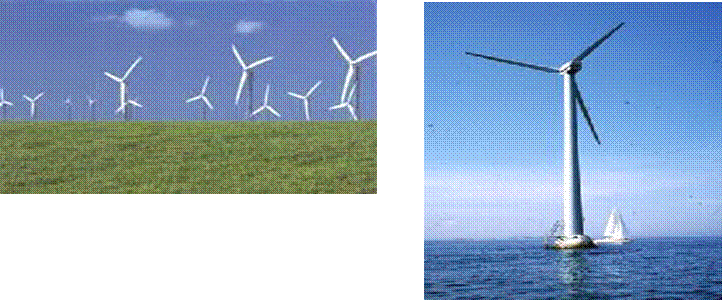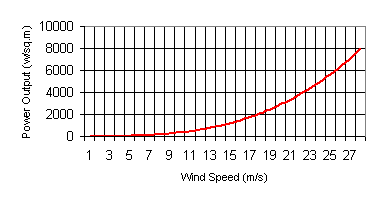[Wind Power]
Introduction, What is Wind Power, Scotland’s Wind Resource, How do we get power from the Wind, How does a wind turbine capture the wind’s energy, Current Technology, Onshore And Offshore Wind Turbines, How do we calculate wind turbine power, Economics, Social Implications, Environmental Aspects, Discussions, Conclusions
![]()
Wind power, like most sources of energy on earth, originates from the sun. As the earth orbits the sun daily, it receives light and heat. The majority of the heat from the sun is received at the equator and it gradually reduces towards both poles. The following figures illustrate that the temperature of the earth varies depending on conditions at that specific location. Across the earth these heat differences help create wind. In warmer regions of the earth the air is hot and is therefore at a high pressure, compared with in colder regions, where the air is at a low pressure. Wind is the movement of air from area’s of high pressure to low pressure.

![]()
![]()
This movement is complicated by several other factors that means wind does not always flow from the equator in the direction of either pole. The rotation of the earth creates a force known as the Coriolis force and this factor along with the temperature differences create winds at high altitudes above the earth on a large scale. These Geostrophic winds play a part in the wind’s that affect us in everyday life, but local winds are largely affected by the surface of the earth – which is neither uniform or smooth. The earth has large flat plains (desert regions), areas covered with plant life (rainforests), very uneven regions (mountain ranges) and very smooth regions (seas and oceans), all of which affect the wind near the surface of the earth to varying degrees. These areas of the earth all have different values of roughness, which can impeded the flow of air. Obviously the lower the value of roughness the less the air is impeded.

There are also more local phenomenon like sea breezes, which are also created by the temperature difference between the land and sea. Land heats more quickly than the sea and will become hotter allowing hot air above the land to rise and flow out to sea, leaving behind an area of low pressure, then the air from the sea can move inshore, creating a sea breeze.
Scotland has the largest available wind resource in Europe. From the diagram we can see that the average annual wind speed are around 6-7m/s or above.
1m/s = 2.4mph

There is currently around 96 MW of wind power capacity installed in Scotland., illustrated in the table below.

With such a large potential resource for wind it is important to capture this free energy and make use of it. The idea of creating something to capture the power from the wind is not a new idea – windmills have been in use since around 200BC - to grind grain or pump water. Technology has advanced and wind turbines are becoming more and more common in Scotland. In order to understand how a wind turbine works the components of a wind turbine must be looked at.

The rotor blades are the elements of the turbine that capture the wind energy and covert it into a rotational from.
The hub is the connection point for the rotor blades and the low speed shaft.
The gearbox takes the rotational speed from the low speed shaft and transforms it into a faster rotation on the high-speed shaft.
The mechanical brake is a physical brake, similar to a disc brake on the wheel of a car, connected to the high-speed shaft. It is used for servicing the equipment to ensure that no components start to rotate, endangering the repair worker.
The generator is connected to the high-speed shaft and is the component of the system that converts the rotational energy of the shaft into an electrical output.
The cooling system is used to ensure that the components do not overheat and cause damage to themselves or any other component. A typical cooling system is either an electrical fan or a radiator system.
The anemometer is used to measure the wind speed and the wind vane is used to note the wind direction.
The yaw mechanism is used to ensure that the rotor blades are parallel to the flow of the wind, to be at their most efficient.
The controller is a computer system that monitors and controls various aspects of the turbine. It has the ability to shut down the turbine if a fault occurs.
The tower is used to support the nacelle and rotor blades.
The
nacelle is the unit located at the top of the tower that encapsulates all the
components of the turbine.
top
In order to see what makes a wind turbine rotate, it is best to look at how aircraft get off the ground. As the wind approaches the aerofoil, it is split into two portions, one over the top and one under the bottom. The airflow over the top moves at high velocity and has low pressure whereas the airflow under the aerofoil is moving at a slower velocity and has a high pressure.

As discussed, previously, wind is created from movement from high pressure to low pressure. The aerofoil has created a pressure difference between the top and bottom of the aerofoil. Therefore the low-pressure air on top of the aerofoil tries to suck the aerofoil and the air under it upwards and the air beneath the aerofoil is trying to push the aerofoil upwards to reach the low pressure. This resulting action is what is known as lift. In an airplane the lift is generated because the large turbine engines force the wings (aero foils) through the air at a high velocity but in a wind turbine we rely solely on the wind to hit the aerofoil, as the wind turbine is stationary.
The blades of a wind turbine are shaped in a similar way to the wings of a plane, with a few small differences. So as the wind ‘hits’ the blade of a turbine the same lift force effects the blade, but since the blade is attached to the central hub of the machine, instead of the lift force causing the rotor to lift into the sky, the blade spins round and round. The blades of the turbine are pitched at a certain angle to obtain the maximum amount of lift from the wind but is impossible to do for all wind speeds.
Wind turbines have been developed with a range of power ratings from a few kilowatts (kW) up to multi-megawatt (MW) capacity. The larger machines are, however, almost all research prototypes. Typical commercially available turbines are now rated at around 600kW. The technology is well established with over 20,000 grid-connected machines world-wide. Current research and development work is concerned mostly with improvements in reliability, cost and noise reduction, and performance.
Large scale generation of electricity requires a number of turbines for economy and ease of generation. In the Scotland groups of about 20 horizontal axis machines may be seen in a typical wind farm. The turbines are usually erected 5-10 rotor blades apart to reduce aerodynamic interaction which impairs their efficiency. Consequently a wind farm of 20 turbines often occupies 3-4 square kilometres of land. The actual ground space taken up by the turbine bases, however, is minimal and the remaining area may be used for agriculture or recreation.
Since wind turbines are available "off the shelf" the time from conception to operation of a wind farm may be as little as a year. Existing designs aim at a machine lifetime of about 25 years. At the end of this, decommissioning is simple, requiring only the removal of scrap material and cabling. The concrete bases, which are only a few cubic metres in volume, are usually buried but can be removed. Unlike many other forms of electricity-generating plant (eg a nuclear power station) there is no residual waste or land contamination following decommissioning.
Progress in UK wind power deployment has not been as rapid as the resource might suggest. Scotland has recently raised its target for the use of green energy from 12% to around 18% by 2010. Much of this increase is expected to be met by new wind farms and could play a large part in the future expansion of a number of wind energy companies
People have been unsure about the true potential of wind and how much of Scotland would have to be covered in Wind turbines to generate sufficient electricity. Similarly, problems have also arisen in trying to get the necessary planning due to a lack of integration between national and local policy. This is changing now, with each region in the UK being required to draw up a sustainable development framework. Wind is still a very unpredictable commodity and does not always produce electricity due to its intermittent nature. At other times it can be very strong and cause vast amounts of damage to structures, as such wind turbines must designed to have a working range of ~4m/s to ~ 25m/s.
One of the most significant factors that could help Scotland increase it’s renewable energy generation capacity is the creation of the offshore wind sector. Scotland has the largest wind resource in Europe, with estimates of the potential capacity from offshore wind energy alone at almost three times the country’s electricity requirements.
The first offshore wind turbines in the UK are already generating electricity at approximately 5p/kWh, the further development of the offshore wind industry is an exciting prospect, and one which will see significant growth over the next decade.
The anticipated contribution from offshore wind energy towards the Government's 2010 target on renewable generation is almost 1/5th, or 1.8% of the total UK supply. Meeting this will require another 1300 turbines, assuming nominal 2MW machines. Blyth Offshore is a vital but small step on the way to meeting this target.
Both onshore and offshore will be necessary to achieve 10%, combined they account for almost half of the target.

The most common type of wind turbine is the horizontal axis type, shown below, which have various considerations. These are so called because the axis of rotation of the blades is in a horizontal position

There are however another type of turbines available vertical axis wind turbine (VAWT). These are again so called because the axis of rotation of the blades is in a vertical position. There are two main types;
 Savonius
Savonius
The
advantage of these types of machine is that they do not have to be faced in
any particular direction with respect to the wind. These machines will work
equally effective irrespective of wind direction. These types of turbines have
not been exploited to any great scale but the Darrieus machines could be used
more in the future.
top
For a wind turbine operating in a wind velocity of V (m/s) with a rotor swept area of A (m2) and air density r, the theoretical power available would be
![]()
This however is only the theoretical power and in practice the value will be a lot less.
A value known as the power coefficient (Cp) is the ratio of the actual power output compared to the theoretical available.
![]()
An analysis from Betz states that the value of Cp is very unlikely to exceed the value of 0.593

It can be seen that the wind speed has an important effect on the power output from the turbine. The power in the wind is proportional to the cube of the wind speed. (If the wind speed doubles – the power output increases by eight times)
The chart shown above represents the Betz Theory power output for a turbine using density as 1.225 kg/m3.
![]()
The tip speed ratio of a turbine is defined as
Where W(rad/s) is the rotor angular velocity and R (m) is the radius at the blade tip.
The financially viable a wind farm is to be will depend on wind speed, cost and performance of a wind turbine installation, and energy prices. Large turbines selling power to the grid can be financially viable where the average wind speed is more than about 7 m/s. They are likely to become attractive to more businesses in future, as technology continues to improve and the deregulated energy market develops. Small turbines and wind pumps may be viable with average wind speeds as low as 5 m/s, if the only alternative is a more expensive power source such as a diesel generator.
In recent years,
the unit cost of wind farm projects has been failing steadily from over £1
000 per kilowatt of rated output to under £700. Even so, the total project
costs for a single large grid-connected wind turbine could be around £500
000, detailed analysis of site wind speeds would have to be carried out to justify
such an investment.
Costs for connecting a wind turbine to the grid can be lower if the site is close to an 11 kV power line, but there may still be reasons that expensive alterations to the grid are needed. There may also be more than one possible arrangement for the grid connection, and a careful technical study of the options can lead to substantial cost savings. There are possibilities for wind turbines on farms to improve the grid supply over a wide area.
For a wind turbine that is not going to be connected to the grid; the costs of alternative energy sources must be compared. Installing a wind turbine involves making a initial large capital outlay that will generate an income over the following 20 years. However electricity prices could change substantially over the duration of a power purchase contract, and could influence returns for the turbine owner, possibly rising along with inflation and possibly rising faster than other prices in future.
Capital outlay will inevitably vary greatly from one site to another. Turbine prices alone mean very little - an estimate for a complete wind power system is much more important. There may be great differences in costs for the wind speed survey, obtaining planning permission, site preparation, and electrical installation. The equipment life is likely to be in the range 15-25 years with the annual maintenance and insurance costs typically ranging between 2-3% of the capital cost. Routine maintenance and lubrication can generally be carried out by farm staff which helps to keep costs down.
There are numerous local and national agricultural grants available to aid the development of wind farms in Scotland. Most are aimed to benefit purchasers of the small and medium sized wind turbines, and would have only a minor effect on profitability of the very large machines.
For more information regarding financial viability check out http://www.britishwindenergy.co.uk/you/sac.html
“Denmark now employs more than 15,000 people in its wind energy industry and meets 13% of its domestic electricity demand from wind turbines.” BWEA
Scotland’s largest wind energy employer is the NOI Scotland factory in Kirkcaldy, specialise in manufacturing glass-epoxy composite blades between 7-23 m in length. The factory currently employs some 90 people, with employment is expected to grow over the next year to around 120. Similarly the Danish wind turbine manufacturer Vestas, a world leader in the manufacture of wind turbines, is also establishing production facilities at Machrihanish in the West of Scotland. Initial plans are for the factory to accommodate tower production and wind turbine assembly. It will cost around £12M to construct and equip and will create 124 direct jobs and 44 associated jobs by 2002.
As
illustrated there are a number of major developers active in Scotland, as well
as a number of specialist consultancy companies. Increasing ‘green’ electricity
capacity has the potential not only reduce the effects of climate change, but
can also create new and sustainable employment opportunities.
top
Many aspects of Onshore and offshore wind have subjective view points. Illustrated below are some of the main factors that usually prompt cause for concern regarding new developments. Some public opinions are illustrated taken the form of a survey Public Attitude to Wind Farms in Scotland carried out by the Scottish Executive, which can be viewed via the link.
Visual Impacts – Many people voice concern about the siting of wind turbines, which are usually located in rural areas. The erection of a wind turbine, usually on prominent land usually has a visual impact on the landscape. Whether this impact is positive or negative is very subjective, with people varying in opinion as to whether turbines add to the landscape or ‘destroy’ the landscape.
“In relation to the visual impact of the wind farm, a higher proportion of respondents said that they liked the look of the wind farm (21%) than the proportion who said the farm was unsightly or spoiled the view (10%).” – Scottish Executive Survey
Noise - Noise is often one of the main worries raised by the public when wind farm proposals affect the surrounding area of people’s homes. When wind ‘hits’ any surface a noise is created. Noise will be created when the wind hits items like trees or shrubs but the wind can also create vibration in some surface, which will then also emit their own noise. From this theory it can be seen that a wind turbine will generate some noise when the blades are rotating. This is generally not a problem anymore as careful design of the blades has reduced the noise emission from turbines. The mechanical workings of the turbine can produce noise - the gearbox, drive train - but are greatly reduced from previous years due to improved engineering practices. The gearboxes used in modern wind turbines are specifically designed for use in wind turbines to reduce the noise emission from them. Noise emission from a turbine is generally not a problem as most turbines are located in rural areas – away from people.
“12% of all respondents had expected to experience a problem with noise, only 1% of respondents had actually experienced a problem and only 2% said unprompted, that they disliked the wind farm because it was noisy.” – Scottish Executive Survey
Flicker - If the blades are rotating and the sun is shining a flicker effect may be induced. This flickering of light could be annoying but again careful planning can ensure that any flicker effect that occurs will not disturb any neighbours of the wind turbine.
Animals - Concern over the impact that wind turbines may have on animals, particularly birds, arise from wildlife groups and the public. The wind turbines will create no obstacle to having wildlife grazing on the same land as the turbine. Obviously birds are a greater concern where they could be killed if they flew into the tower or rotating blades. However, birds are killed every year due to collisions with overhead power lines, poles and even flying into windows and in fact 300 times more birds are killed by collisions with traffic than wind turbines. The impact of wind farms on birds is not great, although consideration must be given when siting turbines to the surrounding habitat of birds and their migration paths.
Electro-Magnetic Interference - In older wind turbines electro-magnetic interference due to the rotating blades and structures of the machines caused problems and interfered in the transmission of television and radio waves. This interference was due to the fact that the turbines used to be made almost completely of metal; nowadays turbines are predominately constructed using fibreglass, which creates little or no interference.
Different types of wind turbine have varying numbers of blades, with older windmills having many blades on the rotor. These older machines used drag forces rather than lift forces to turn the rotor so the more blades that the drag force affected the better. More common in Scotland are three blade turbines that use lift forces to turn the rotor. The three blades system is preferrd due to issues of stability. Obviously you could still use numerous blades but this raises the cost of the machines as you have more blades to manufacture and the structure requires reinforcing to cope with the additional weight.
The manufacture of two bladed machines can save money but require a higher wind speed than three bladed machines to produce the same power output. This problem also adds to the problem of noise produced from a turbine. Single blade machines are not widely used due to the enhancement of the problems associated with the two bladed machines. Stability becoming an increasing problem and require the position of a counterweight on the opposite side of the hub.
Another deciding factor is whether to put the blades upwind or downwind of the rotor. Most machines in use today are upwind machines. An upwind machine has the blades in front of the nacelle with respect to the wind flow. Upwind machines have the advantage of avoiding any wind shade created by the tower but do have to have the yawing mechanism in place to keep the blades perpendicular to the wind flow.
Downwind machines have the blades placed after the nacelle with respect to the wind flow. The advantage of this design is that the machine does not need a yawing mechanism present, as the machine will automatically yaw into the wind. The downside of a downwind machine is that the power output may fluctuate due to the wind shade created by the tower.
It has long been suggested that Scotland has the best wind energy potential in Europe, recent studies suggest it is a hefty 23% of the total.
The debate about whether or not Scotland has enough potential wind to supply a considerable amount of it’s energy demand is still ongoing. The strength of the argument is increasing and the people of Scotland and the Scottish Executive are realising is that wind can play an important part in Scotland’s future.
The important thing to realise is there is a big gap between the potential available energy and what can reasonably be harnessed. Although independent consultants have found there is enough potential from onshore wind power to meet Scotland's peak-winter demand twice over. How much of this we can use is uncertain and at what cost is not yet known.
![]()
Home, Beginners Guides, Wind Case Studies, Urban Wind, Small Scale
![]()